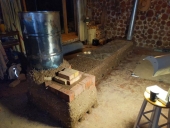Hello,
i´ve got a bunch of questions concerning the use of concrete pavers for a RMH bench.
The bench will be situated in a rented workshop shack. Normally you think of instant heat for a workshop, but I can play music in there without disturbing anybody anytime so I like a bench that stays warm, also for the benefit of dry tools/machines and glueing wood in winter.
So conditions are that the bench shoud be removable with reasonable effort if I move out one day, and I gathered lots of concrete pavers (urbanite rocks) for the thermal mass. It is planned to be simply rectangular.
My initial plan was to construct the bench as a hollow "bell" mortared and sealed with cob (see cross-section-pic).

My worries with this are:
* Is the single seal of a cobbed gap safe enough ?
* Will I be able to resoak the cob mortar in the small but wide gaps between the pavers if I have to dismantle it ?
* And the main objective: If it´s cool and there will probably be lots of initial condensation from the exhaust, will this water puddle on the bell floor and/or soften the cob mortar and spill out ?
So I stopped to rethink the plan and came up with another solution that uses a flue run with a 180 degree-turn at the far end.
Coss-section plan looks like this:

Plan for this is to loose-stack all the pavers (except for the bricks at the top that will be cobbed in) for easy and quick assembly and dismantling. Questions:
* The pavers got a rough surface of embedded stones on one side, will the little air gaps between them harm heat conduction ?
* What will be the best infill directly around the duct ? I was thinking either to use pebbles (insulation issue ?) or to use a cob mixture that is more on the sandy side.
Any thoughts & comments which way to proceed are highly welcome !
Ralf








